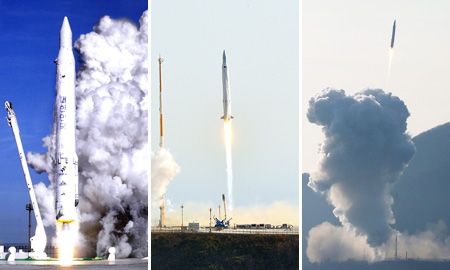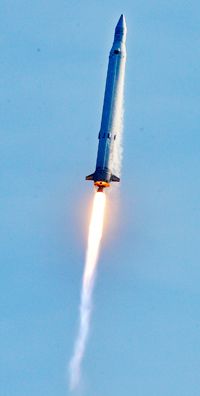Naro launch is blazing success!

The sequence of photos shows the Korea Space Launch Vehicle 1, popularly called Naro, blasting off from the launch pad at the Naro Space Center in South Jeolla Province, and soaring through midair on its way to a successful launch, redeeming the country after consecutive failures in 2009 and 2010. Officials at the Korea Aerospace Research Institute confirmed minutes later that the rocket had successfully put its payload satellite into orbit. / Yonhap
Satellite payload in orbit
GOHEUNG, South Jeolla Province ― South Korea was third time lucky in its aspirations to join the Asian space race Wednesday after successfully launching a two-stage rocket from its Naro Space Center on the country’s southwestern coast.
Korea is the 11th country joining an elite group of nations capable of sending rockets into space to launch satellites. Such an achievement comes nearly 10 years after Asia’s fourth largest economy began seeking its own capability to place a satellite into orbit.
Engineers at the Korea Aerospace Research Institute (KARI) said the rocket, the Korea Space Launch Vehicle-1 (KSLV-1), succeeded in putting its satellite payload into orbit. Whether the satellite is functioning properly will be confirmed through radio communication Thursday.
“Thanks to the successful launch of Naro, we are now one step closer to becoming a space power,” said Lee Ju-ho, minister of education, science and technology, in a press conference after the launch. “I want to thank everyone involved for their support and efforts.”
“I think failure is the essence of science. We learn through failure and endlessly face new challenges,” he added, referring to previous disappointments in 2009 and 2010.
Officials of the institute said that a radio station in Norway successfully received signal from the satellite in orbit.
With North Korea’s successful rocket launch in December, the pressure has never been higher for the team of experts at KARI.
“I want to take this moment to apologize to the people of Korea for the two previous failures and taking so long,” said Cho Gwang-rae, who heads the Naro project at KARI. Cho said the priority during the countdown was to make sure replacements for previously malfunctioning parts worked.
Previous launches in 2009 and 2010 failed and the third and final attempt had already been postponed twice due to technical reasons.
In 2009, the rocket reached the desired speed and height but failed to deliver its satellite payload. On the second attempt in 2010, the Naro exploded mid-flight.
The rocket was launched at 4 p.m., reached an altitude of 177 kilometers after 54 seconds and successfully separated the fairings that protected the payload. The first stage was released at 3 minutes 52 seconds.
At 4 minutes 54 seconds, the second stage activated without problem and the rocket reached its desired orbit after 8 minutes 15 seconds at an altitude of 303 kilometers. Ten minutes after launch, KARI announced the rocket had successfully reached orbit and released the satellite payload.
“I stood up and clapped when I saw the news of the successful release of the payload,” said one KARI official. “Our teams of 100 engineers have works so hard tirelessly and I am immensely happy that we succeeded.”
During a media briefing hours before launch, Rho Kyung-won an official from the Ministry of Education, Science and Technology said there were no problems during the final check-up in the morning before the start of fuelling.
There were also no hitches detected during the previous day’s final rehearsal.
KARI officials said the Naro project has doubled the level of Korean space technology. The agency says it is about 80 percent that of developed countries in terms of sophistication.
The KSLV-1 project began in 2002 in cooperation with Russia. Under a cooperative and technology safeguard agreement in which Moscow agreed to assist in three launches, Korea was responsible for the second stage, its solid-fuel motor and the payload. Russia made the first stage and the liquid-fuel engine.
The Naro weighs 140 tons and has a length of 33 meters. The project cost over 520 billion won, with the Naro Space Center built near the sea at Goheung taking up 300 billion won. <The Korea Times/Cho Mu-hyun>






















































